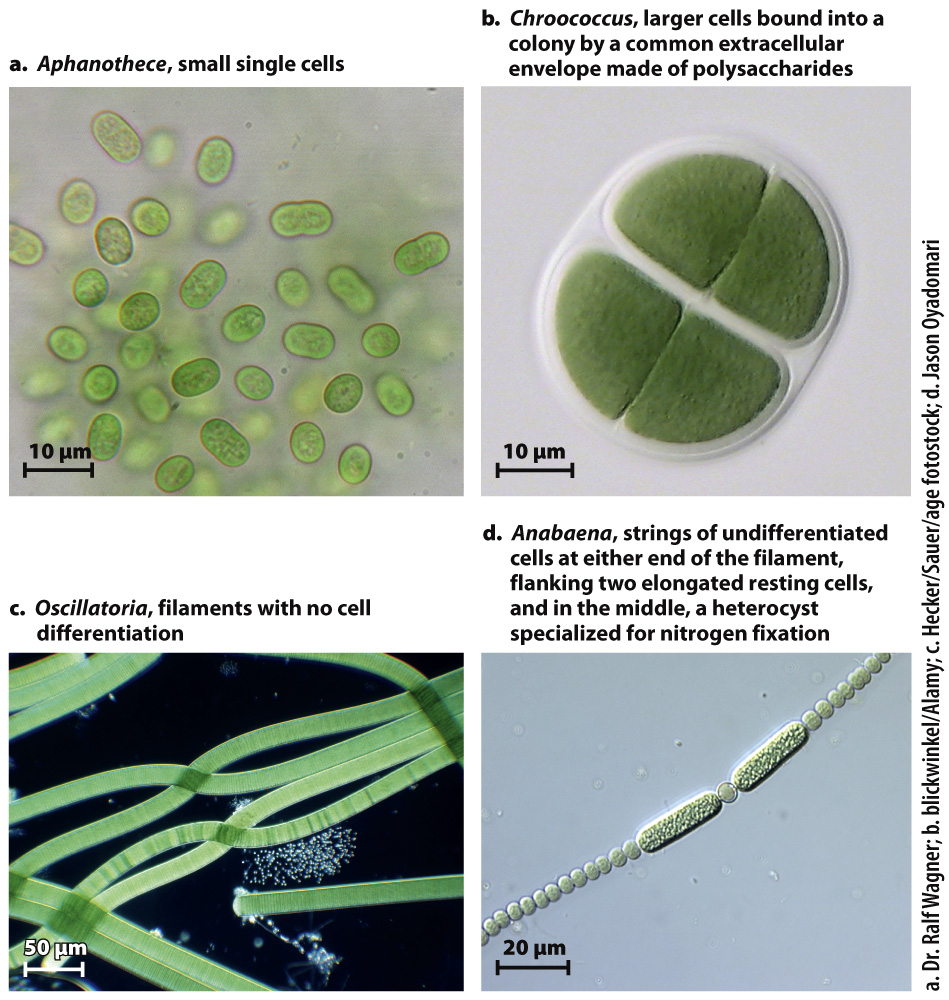Photosynthesis is widely distributed on the bacterial tree.
Molecular studies confirm that all bacteria capable of oxygenic photosynthesis form a single branch of the bacterial tree: the cyanobacteria. Cyanobacteria can be found in environments that range from deserts to the open ocean. Their diverse species include unicellular rods and spheroidal cells, as well as multicellular balls and filaments (Fig. 26.16). Some filamentous cyanobacteria can even form several different cell types, including specialized cells for nitrogen fixation and resting cells that provide protection when the local environment does not favor growth.

FIG. 26.16 Diversity of form among cyanobacteria.
In contrast to the monophyly of cyanobacteria, molecular sequence comparisons show that anoxygenic photosynthesis is distributed widely on the bacterial tree (see Fig. 26.15). Think of the purple layer beneath the surface of many microbial mats (see Fig. 26.7). The vivid color comes from the light-sensitive pigments of the aptly named purple bacteria, found within the Proteobacteria. Purple bacteria are capable of photoautotrophic growth using bacteriochlorophyll and a single photosystem. Most, however, show evidence of metabolic diversity and can grow heterotrophically in the absence of light or appropriate electron donors. A green layer lies beneath the surface of other microbial mats, its color caused by light reflected by the pigments of another group of photosynthetic bacteria, called green sulfur bacteria because they commonly gain electrons from hydrogen sulfide and deposit elemental sulfur on their walls. Unlike most groups of photosynthetic bacteria, the green sulfur bacteria are intolerant of oxygen gas. Oddly, a species of green sulfur bacteria has been found in hydrothermal rift vents 2 km beneath the surface of the ocean. Light doesn’t penetrate to these depths, so if these organisms harvest light, it must come from incandescent lava as it erupts on the bottom of the ocean.
Light-harvesting bacteria occur on several other branches of the bacterial tree—the photoheterotrophic heliobacteria, for example, and the green nonsulfur bacteria often found in freshwater hot springs. Despite a century of research, our knowledge of photosynthesis within the bacterial tree remains incomplete, as illustrated by the discovery in 2007 of unique light-harvesting bacteria in Yellowstone National Park. Genomic surveys of hot springs turned up evidence of a previously unknown bacteriochlorophyll-containing microorganism, and gene sequencing established that this organism belongs to the phylum Acidobacteria. There is no evidence for carbon fixation, however, suggesting that the Yellowstone bacterium is a photoheterotroph. To date, these unusual microorganisms have not been grown in pure culture, so they remain difficult to study.
